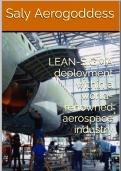These
LEAN-SIGMA deployment within a world-renowned aerospace industry
- Cours
- Établissement
In order to face business competition, the main objective of every company is to be recognized by their customers for the quality of their products, and to meet their requirements in an optimal way in terms of time and cost. It has therefore become important to prepare well for the new pace of cust...
[Montrer plus]



